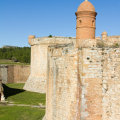LA FORTERESSE DE SALSES
This impregnable fortress, capable of withstanding any attack, is a historical and architectural marvel to be discovered.
A masterpiece of military architecture. The edifice is a true specimen of the transition between the medieval castle and the modern geometrical, sunken fortress. It commanded the border between Roussillon, then part of Spain, and the kingdom of France. In the heart of the wine-growing plain, the huge brick and stone walls sink into the ground. The rectangular fort covers almost a hectare. It is surrounded by ditches 12 to 15 meters wide and 7 meters deep. The rampart is 12 meters thick, with only the top part protruding above ground level, to provide even greater resistance to artillery fire. It features the classic elements of medieval defensive architecture: moat, keep, loopholes, curtain walls and drawbridge. The living quarters under the parapet walk were designed for 1,500 men (the stables for 300 horses!). The seven-storey high keep was designed to house the governor.
Salses, gateway to Roussillon. Since ancient times, this highly strategic location on the Via Domitia, which led to Cadiz, has been a stronghold. But it was not until 1497 that King Ferdinand of Spain initiated plans for an impregnable fortress capable of withstanding cannonballs and all the latest innovations in the art of warfare. During the many conflicts between France and Spain, Salses changed hands frequently, until 1659, when the Treaty of the Pyrenees was signed. Roussillon now belonged to Louis XIV's France.
Did you know? This review was written by our professional authors.
The strengths of this establishment:
Members' reviews on LA FORTERESSE DE SALSES
The ratings and reviews below reflect the subjective opinions of members and not the opinion of The Little Witty.










enfants.